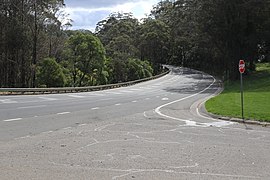Bells Line of Road | |
|---|---|
 | |
| Mount Tomah, Australia | |
| Coordinates | |
| General information | |
| Type | Road |
| Length | 58.6 km (36 mi)[1] |
| Gazetted | August 1928[2] |
| Route number(s) | |
| Former route number | |
| Major junctions | |
| West end | Bell, New South Wales |
| Darling Causeway | |
| East end | Richmond, Sydney |
| Location(s) | |
| Major suburbs | Mount Tomah, Berambing, Bilpin, Kurrajong Heights, Kurmond |
| ---- | |
Bells Line of Road is a 59-kilometre (37 mi)[1] major road located in New South Wales, Australia, providing an alternative crossing of the Blue Mountains to the Great Western Highway. The eastern terminus of the road is in Richmond, 51 km northwest of Sydney, where the road continues eastward as Kurrajong Road, which intersects the A9. The western terminus of the road is in Bell, in the Blue Mountains, where the road continues as the Chifley Road.
The route, part of the traditional Aboriginal pathway network, was shown to Archibald Bell, Jr. by Darug men Emery and Cogy in 1823.[3][4] Subsequently, he was accompanied by the Government Assistant Surveyor and the route marked was known as Bell's Line, to be later cleared to become the second road across the Blue Mountains. Due to its condition and the gradients around Mount Tomah it was rarely used before World War II. The road was improved between 1939 and 1943, as an alternative to the Great Western Highway for the war effort. At the same time that it was improved, the road from Bell via Scenic Hill to Lithgow was built, so that the Darling Causeway (the conjoining road connecting Bell and Mount Victoria) carries relatively little traffic, but is a significant tourist route.
Today, the route is still used as an alternative route across the Blue Mountains and is also a popular tourist drive.
- ^ a b "Bells Line of Road" (Map). Google Maps. Retrieved 19 August 2022.
- ^ "Main Roads Act, 1924-1927". Government Gazette of the State of New South Wales. No. 110. National Library of Australia. 17 August 1928. pp. 3814–20. Archived from the original on 3 August 2022. Retrieved 1 August 2022.
- ^ "Magistrate for the Ensuing Week, Alexander Berry, Esquire". The Sydney Gazette And New South Wales Advertiser. Vol. Twenty–First, no. 1038. New South Wales, Australia. 9 October 1823. p. 2.
- ^ "Hawkesbury Valley". Greater Blue Mountains Drive. Archived from the original on 30 May 2014. Retrieved 29 May 2013.
